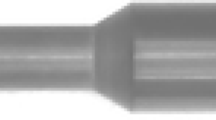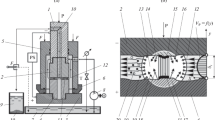Conclusions
-
1.
Comminution of tungsten carbide and cobalt powders in an ultrasonic field yields mixtures of uniform particle size and ensures excellent mixing of the mixture components, combined with extremely high productivity.
-
2.
The optimum liquid-to-solid ratio of the suspension is determined by the specific conditions of ultrasonic treatment. For comminution in a hermetic vessel under pressure, the recommended ratio is 1∶1 when the cavitation process is performed in ethyl alcohol, which possesses excellent cavitation properties and exerts no harmful effect on the powder being treated.
-
3.
The most intense comminution of the powder occurs during the initial period of ultrasonic treatment. The character of the variation in the mean probable powder particle size is the same in comminution in an open vessel and in comminution under pressure. The greatest intensity of comminution is achieved when the powder is treated under pressure in the UZVD-6 apparatus.
-
4.
Productivity in ultrasonic treatment rises with increase in the vibration amplitude of the concentrator tip and depends on the depth to which the concentrator is immersed in the medium being treated.
-
5.
To obtain a mixture of uniform particle size, the treatment time for a powder with initial particle sizes ranging from 0.5 to 6μ may be taken to be 60 min. When smaller particles are required, the treatment time should be extended.
Similar content being viewed by others
Literature cited
W. T. Richards, J. Am. Chem. Soc.,51, 1724 (1929).
N. S. Rshchevkin (Rschevkin) and E. Ostrovskii (Ostrovsky), Acta Phys. Chim. USSR, 1, 741 (1935).
B. A. Agranat, V. I. Bashkirov, and Yu. I. Kitaigorodskii, in: Progress in the Theory and Practice of Application of Advanced Ultrasonic Techniques in Engineering [in Russian], Mashgiz (1965).
M. S. Germanidze and Yu. N. Tyurin, in: High-Temperature Inorganic Compounds [in Russian], Naukova Dumka, Kiev (1965).
B. G. Novitskii and V. A. Anisimova, in: Ultrasonic Techniques [in Russian], No. 1, TsINTIAM, Mashgiz (1965).
V. I. Tret'yakov, Sintered Hard Alloys [in Russian], Metallurgizdat (1962).
Author information
Authors and Affiliations
Additional information
Translated from Poroshkovaya Metallurgiya, No. 3 (99), pp. 93–96, March, 1971.
Rights and permissions
About this article
Cite this article
Letunovskii, V.V., Androsov, V.N. & Petrovskii, É.A. Preparation of mixtures of tungsten carbide and cobalt by means of ultrasonic vibrations. Powder Metall Met Ceram 10, 244–246 (1971). https://doi.org/10.1007/BF00796719
Received:
Issue Date:
DOI: https://doi.org/10.1007/BF00796719




